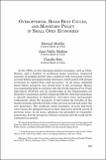Artículo
Overoptimism boom-bust cycles and monetary policy in small open economies
Date
2009Abstract
In the 1990s several emerging market economies such as Chile Mexico and a number of southeast Asian countries displayed episodes of peaking growth rates combined with increasing current account deficits and appreciating currencies which ended with abrupt reversions in capital flows and recessions. In all cases optimism about future prospects was strong prior to the recessions. Mexico was negotiating both its entrance into the North America Free Trade Agreement (NAFTA) and its membership in the Organization for Economic Cooperation and Development (OECD). Chile had undergone a smooth transition to democracy. Investors were increasingly enthusiastic about the prospects of harvesting the benefits of the market reforms introduced both in the previous period and under the new democracy. The southeast Asian economies in turn had their own reasons for optimism based on their impressive growth record of previous years. In all cases optimism was grounded on reasonable arguments but the prospects of future economic growth could not be estimated accurately.
Collections
View/


